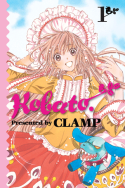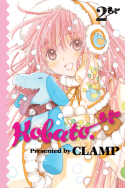The following discussion contains spoilers.
MICHELLE: For this month’s CLAMP Manga Moveable Feast, special guest Karen Peck and I decided to weigh in on couple of the quartet’s shorter works, namely Suki (complete in three volumes) and Legal Drug (unfinished in three volumes, but newly relaunched in Japan under the name Drug & Drop). I’d heard these series were related in some way, too, though that turned out to be little more than a cameo.
 Anyway, let’s start with Suki! Child-like Hinata Asahi is a first year in high school who is extremely book smart, but trusting to an excessive degree. She lives alone with two teddy bears, and when the guy who moves in next door turns out to be her substitute homeroom teacher, Hinata takes a liking to him. Shiro Asou is kind of prickly, but does a few things for Hinata that make her feel all warm and fuzzy, like patting her on the head and helping her sweep some leaves in her yard. Hinata’s obvious affection for Asou-sensei troubles her friend, Touko, and it’s Touko’s concern (coupled with hinting about Hinata’s past) that lends a welcome ominous vibe to the story.
Anyway, let’s start with Suki! Child-like Hinata Asahi is a first year in high school who is extremely book smart, but trusting to an excessive degree. She lives alone with two teddy bears, and when the guy who moves in next door turns out to be her substitute homeroom teacher, Hinata takes a liking to him. Shiro Asou is kind of prickly, but does a few things for Hinata that make her feel all warm and fuzzy, like patting her on the head and helping her sweep some leaves in her yard. Hinata’s obvious affection for Asou-sensei troubles her friend, Touko, and it’s Touko’s concern (coupled with hinting about Hinata’s past) that lends a welcome ominous vibe to the story.
KAREN: Ah, Suki! I read this when it first came out, and thought it was a nice little trifle—enjoyable but not especially notable. Hinata is one of those CLAMP heroines who is impossibly sweet and naïve, but it’s forgivable—because she should be a darker, sadder character, what with living alone in an empty house, her father only a distant figure, and having been through some intense events in her past. In Cardcaptor Sakura, you could see where all of [Sakura’s] abundant sweetness comes from—she comes from a world of love and security. That Hinata is still such an innocent, despite her situation, is very interesting.
It’s that ominous vibe you noted, Michelle, that does make this story a little more interesting—I think three volumes of Hinata and teddy bears would have been adorable, but pure fluff. Reading through the series, I also like the ambiguity of Asou-sensei—despite HInata’s affection for him, the story really feels like it’s building him to be another bad thing in Hinata’s life.
MICHELLE: HInata actually reminded me quite a lot of Sakuya from Natsuki Takaya’s Twinkle Stars, both in her demeanor and with the family secrets lurking in the background. (I think the similarity also sprung to mind because it was another case where I was used to reading a creator’s fantasy-infused manga but was now reading something taking place firmly in the real world.) But yes, one has to wonder how she was able to maintain her trusting spirit despite, we later learn, having been kidnapped nine times as a child.
I definitely enjoyed the build suggesting Asou-sensei was going to do something nefarious, and I admit to being disappointed that he merely turned out to be a bodyguard sent by Hinata’s father. The whole setup—lonely, selfless teen falls in love with enigmatic older guy—reminded me a little of Tokyo Babylon, but in the end CLAMP follows a more stereotypically shoujo storyline by offering redemption and a happy ending. It felt like all of the wonderful worrying Touko got up to just kind of petered out into very little payoff.
KAREN: Maybe Hinata maintains her child-like spirit by reading cute books about teddy bears? The book-within-the-book, another Suki, is precious.
I didn’t mind the payoff/ending. Terrible things happened to Hinata—and I’m sure that this kidnapping was a good deal more personal than past ones—but she remains unchanged. Hinata is still the same trusting person she always was, as was foreshadowed in a conversation with Asou-sensei—after he warned her that she would be sorry for living in her dream world, she replied, “No, I won’t. The people around me are all people I love. None of them are bad people. Not now, not ever.” And this plays out in the end—not only does she forgive her kidnappers, she convinces her father to help them. While a dark ending would have been more interesting, this story, for all the hints otherwise, was always going to be sweet. Like in CCS, a kind-hearted girl is tested but not broken, and continues on to share her loving nature with those around her.
MICHELLE: Yeah, you’re totally right. And I guess they can’t all be shocking endings, otherwise they would cease to be shocking!
I did like the book-within-a-book segments, something that we also see a little later in Chobits. If it didn’t involve a lot of physical labor to unearth my copies, I could check to see if the author of those picture books was the same Tomo! But I am lazy.
KAREN: I’ve not even read Chobits, so I’m no help whatsoever!
So my old assessment—that it’s a nice little story, prettily told—remains true for me after this re-reading. Not one of the great classics of CLAMP’s, but enjoyable all the same.
MICHELLE: I can agree with that!
 Moving on to Legal Drug… as mentioned in Friday’s Let’s Get Visual post, this is a series that gets compared a lot to xxxHOLiC. Seventeen-year-old Kazahaya Kudo has run away from home and been rescued by Rikuo Himura. Both of the boys are live-in workers at Green Drugstore, managed by the enigmatic Kakei, and also take on the occasional odd job for their employer, which typically involve using Kazahaya’s ability to see visions when he touches people and objects to find various items.
Moving on to Legal Drug… as mentioned in Friday’s Let’s Get Visual post, this is a series that gets compared a lot to xxxHOLiC. Seventeen-year-old Kazahaya Kudo has run away from home and been rescued by Rikuo Himura. Both of the boys are live-in workers at Green Drugstore, managed by the enigmatic Kakei, and also take on the occasional odd job for their employer, which typically involve using Kazahaya’s ability to see visions when he touches people and objects to find various items.
Kazahaya and Rikuo aren’t friends, and fall into the spazzy/stoic dynamic characteristic of the early Watanuki/Doumeki relationship. There seems to be more overt romantic chemistry between them, however, which CLAMP plays up in the third volume, which finds them going undercover at an all-boys’ school.
KAREN: First, on a totally shallow level, I love Tokyopop’s presentation for Legal Drug. Vellum! Color pages! I’m totally a sucker for things like that.
I get the xxxHOLiC comparison; it’s one I’ve used before to describe it. However, Kakei isn’t quite Yuuko, luckily for Kazahaya and Rikuo!
My enjoyment of this series has always been tempered by its unfinished status—I really was wanting more details about the boys’ past which had been teased throughout the entire series. But what did you think of the stories—the “jobs,” Michelle? I think that they tended to be more personal than the stories in xxxHOLiC, which made them a little more central to the story.
MICHELLE: I think that if I had read this previously—before the resumption of the series in Japan—I would’ve been extremely frustrated by the lack of follow-through with the hints and glimpses we get of Kazahaya’s twin sister, Kei, and the mysterious woman in Rikuo’s past, Tsukiko. Now, I can feel more confident that CLAMP will address those story elements, even though there’s no guarantee we’ll ever see Drug & Drop in English.
As for the jobs, it’s been so long since I last read xxxHOLiC that I can’t really compare them, but I do agree about them seeming very central to the story. What first comes to mind is the cat that the boys rescue, who initially seems ordinary, then is revealed to be something supernatural, and then thanks its rescuers by showing them images of Kei and Tsukiko. That’s a perfect example of what you’re talking about, I think.
KAREN: Drug & Drop is now being published in a seinen magazine, so if we ever get to see it here, it will be interesting to see how it changed—will Kazahaya be in a dress as often?
Going back to our first title, there is a cameo by Hinata and Asou-sensei from Suki in volume two (chapter nine) which only shows that sometime after the events of that series, Hinata is still the same girl—who would think that there’s nothing odd about a strange boy asking for her school uniform, and who is able to draw others out. It’s a nice callback for a cameo.
Because the jobs tend to be about objects rather than people, the stories don’t have the larger emotional punch that some of the xxxHOLiC ones do, but that does allow Kazahaya and Rikuo to have more of the focus. I also liked how most of volume three was about one job—and that gave the story of the school and Nayuki room to breathe. It was a little dark at times, and maybe rambling, but it worked…
MICHELLE: I liked that about it, too, though I admit being a little annoyed at how much flailing about Kazahaya seemed to do during that story. It almost seems like the manga takes a sharp turn into generic BL, with the sudden schoolboy dynamic, Rikuo doing a little too well with his pushy seme impersonation, and the random school traditions of voting for a pretty boy to be a “bride” who wears the costume of his fans’ choice, but there were some nice ominous turns to keep it from worrying me too much. I am fairly certain the seinen Drug & Drop will definitely have less of that, though.
KAREN: There was a lot of flailing through the entire series, and I agree with you that it could be annoying. I get it, there’s tension/chemistry. But I like Kazahaya and Rikuo, and Rikuo is never creepy in his pushy seme moments, so I don’t mind it overall. But I don’t like being teased—I hope that running in a seinen mag, the new series can build their relationship with less blushing into something more concrete to where we see some solid character development.
Post-xxxHOLiC, I like Legal Drug less than I remember. Hopefully whatever CLAMP has in store with the characters in Drug & Drop will provide some satisfaction. As Kakei said in the last chapter of volume three, “We’ve been waiting a long time… for that boy and Rikuo to meet,” so hopefully we’ll see where this is all supposed to go.
MICHELLE: Well put! We share the same hopes for this series, it sounds like.
Thank you for joining me in this conversation today!
KAREN: And thank you for the opportunity!






















Recent Comments